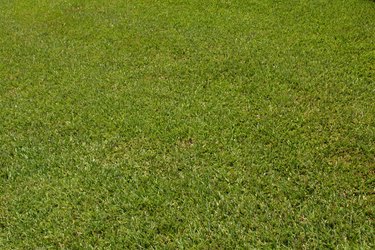
Moisture plays an important role in fertilizing your lawn. Moisture carries nutrients such as nitrogen to plant roots by helping the fertilizer to break down and soak into the soil. Too much moisture, though, presents problems. Thus, it is important to leave adequate time between the day you fertilize and the next rainfall.
Moisture Factor
Video of the Day
Typically, you should fertilize when no rainfall is expected for two days. If rainfall is expected to be light, though, you might have options. You need to add ¼ to ½ inch of water to your lawn in the 24 hours immediately following fertilizer application. You then need to allow up to 48 hours for the fertilizer to soak into the soil. Rain, though, can substitute for watering. This conserves water for other uses. To much rain washes away the fertilizer before it is able to soak into the soil. Often, it is best to play it safe with your investment. This means fertilizing two days before rain arrives. The Southwest Florida Water Management District places the necessary time period between fertilizing and rainfall at 36 hours. Thus, you need not worry if rain comes a few hours before two full days have passed.
Video of the Day
Pollution Considerations
Many citizens today are concerned with fertilizer application due to its impact on the environment, and much of that impact is exacerbated by rainfall immediately after a fertilizer application. Fertilizer runoff flows into lakes, rivers and streams. This can cause a spike in water-based plants, particularly algae. Algae blooms then die off, leaving decomposing vegetation in the water. This reduces the oxygen supply in the water, which affects fish and other aquatic species.
Read Packaging
Although general guidelines provide a sound basis for your fertilizing considerations, products vary. For example, you need to allow 24 to 48 hours before applying any moisture if you use a weed and feed product, which combines fertilizer with weed killer.
Many fertilizers produced today feature slow-release nitrogen components. This means the nitrogen takes more time to soak into the soil and it sits on your lawn for a longer period. Therefore, it needs regular levels of moisture to help with soaking into the soil but also is susceptible to washing away over longer periods of time if flood conditions exist. Slow-release nitrogen in your fertilizer is likely to be washed away if you are in an area where extreme flooding is likely during certain times of the year.
Apply only the amount of fertilizer that is recommended. Some homeowners alleviate concerns about rainfall by overapplying fertilizer. Although this might not have a negative impact on the lawn, it increases the amount of fertilizer likely to run off into lakes, rivers, streams and even the city's water supply.